Imagine the chaotic symphony of moving day—the shuffle of boxes, the hum of anticipation. In this dynamic scenario, of the art of elegant relocation unfolds, clothes packaging ideas plays a vital role.
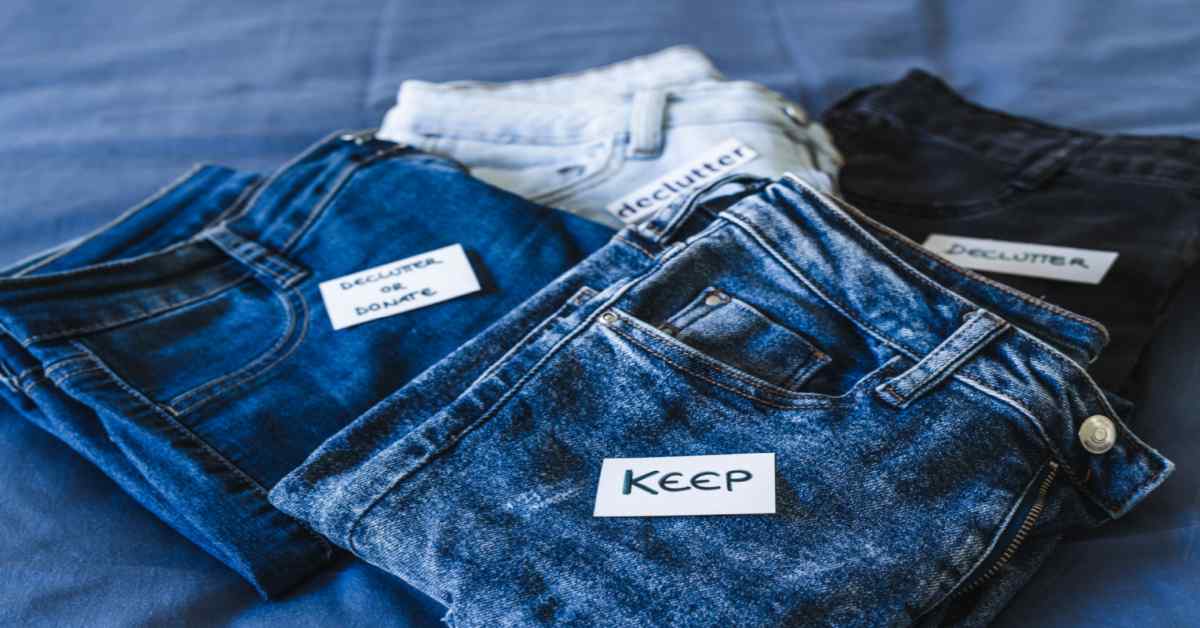
Things we covered for you
Join us on a journey where innovative packing transforms into an art form, promising not just protection for your clothes but an infusion of sophistication. In this exploration let’s learn how thoughtful packing can turn the mundane chore into a symphony, ensuring your garments arrive not just intact but ready to adorn your new space with grace.
Assess and Declutter Your Wardrobe
Moving to a new home can be an exhilarating adventure, but the process of packing up your life can be daunting, especially when it comes to your wardrobe. Let’s explore essential tips to help you assess and declutter your wardrobe, ensuring a smoother transition to your new abode.
1. Embrace the Purge
Before diving into the packing process, take a moment to embrace the power of decluttering. Consider this a golden opportunity to sift through your clothes and bid farewell to items that no longer serve you. Challenge yourself to assess each piece, asking the crucial question: Have I worn this in the past year? If the answer is a hesitant ‘no,’ it might be time to part ways.
Pro Tip: Utilise a decluttering checklist to stay organised and focused during this process. Additionally, hosting a garage sale can be a rewarding way to lighten your load and make some extra moving money.
2. Make Room for a Laundry Day
Once you’ve identified the clothes destined for your new home, make sure they’re moving-ready. It’s tempting to leave this step until later, but a preemptive laundry day will pay off in the long run. Clean, fresh clothes not only ensure a pleasant unpacking experience but also safeguard your garments from potential stains and odours that can develop during the moving process.
3. Sort by Season
Take a strategic approach to packing by sorting your clothes based on the current season. If you’re moving during summer, pack away winter wear and vice versa. This not only saves space but also helps you stay organised when unpacking at your new destination. Remember, the more efficiently you pack, the smoother the transition.
4. Maximising Space with Compression
For those bulky winter items that won’t be needed during the move, consider investing in compression bags. These handy storage solutions not only save space but also keep your clothing items in pristine condition. Vacuum-sealed bags are not just for clothes; they work wonders for pillows, comforters, and other large, soft home goods.
5. Master the Art of the Roll
When it comes to packing clothes without sacrificing space or causing wrinkles, the army roll is your best friend. This technique maximises space while minimising creases. Opt for rolling-over folding, as it not only saves space but also prevents unsightly wrinkles. A tidy roll is key to ensuring a smooth unpacking process.
6. Wardrobe Boxes
For a quick and efficient packing solution for hanging clothes, consider wardrobe boxes. They provide a protective casing for your garments and streamline the packing process. However, use them judiciously, as they can be more expensive and take up significant space in a moving truck.
Remember, a well-organised and decluttered wardrobe not only eases the moving process but also sets the stage for a fresh start in your new home. By embracing these clothing packaging ideas, you’ll not only save time and space but also arrive at your destination with a wardrobe that truly reflects your style and personality.
Elevate Your Move with a Pre-Move Laundry Day

Embarking on a move brings with it a myriad of tasks, and amidst the chaos, it’s easy to overlook the significance of preparing your clothes for the journey. Let’s delve into the crucial step of planning a pre-move laundry day, highlighting why it’s a game-changer in ensuring a smooth and seamless transition to your new home.
Read: Best Packers and Movers in Kannamangala Bangalore
Fresh Start with Fresh Clothes
Before you start packing, consider the power of a clean slate – or, in this case, a clean wardrobe. A pre-move laundry day is more than just a chore; it’s an investment in the hassle-free unpacking and storage of your clothes at your new destination. Clean clothes not only contribute to a more pleasant unpacking experience but also safeguard your cherished garments from the potential perils of the moving process.
Pro Tip: Think of it as a symbolic fresh start in your new home – leaving behind the dust and stains of the past, and stepping into your new space with a wardrobe ready for new adventures.
The Unseen Benefits of Clean Clothes
It’s easy to underestimate the benefits of moving with freshly laundered clothes. Beyond the obvious allure of a clean and fragrant wardrobe, there are practical advantages that can make your move a breeze. Stains and odours accumulated during the packing and transit phases can be avoided with a proactive approach to cleanliness.
Ease of Unpacking
Imagine opening a box and being greeted by the crisp scent of freshly laundered clothes. The ease of unpacking is not just a physical experience but a sensory one. Arriving at your new home with clothes that are ready to wear eliminates the need for immediate laundering and allows you to focus on settling into your new space.
Protect Your Garments
During the hustle and bustle of a move, clothes are vulnerable to stains, creases, and odours. Washing them beforehand provides an extra layer of protection, ensuring that your garments endure the journey unscathed. This is particularly crucial for delicate fabrics and special occasion wear that require a little extra care.
A Tidy Transition
A pre-move laundry day sets the stage for a tidy transition. Neatly folded and freshly cleaned clothes are not only a delight to unpack but also contribute to an organised move. Imagine effortlessly finding your essentials without the hassle of sorting through dusty or wrinkled garments.
As you prepare for your move, don’t underestimate the impact of a pre-move laundry day on the overall moving experience. By taking the time to wash and pack your clothes thoughtfully, you’re not just ensuring their cleanliness but also setting the foundation for a smoother, more enjoyable transition to your new home.
Read: Top 10 Best Packers and Movers in Pune for Stress-Free Moving!
Mastering the Art of Seasonal Sorting for Effortless Moves

When it comes to moving, strategic planning can make all the difference, especially when tackling the contents of your wardrobe. Seasonal sorting strategy offers you a comprehensive guide on how to pack clothes based on the season and provides tips on selecting the right attire to pack first, depending on the time of year.
The Seasonal Shuffle
Packing for a move requires a bit of seasonal savvy. Start by categorising your wardrobe based on the time of year. If you’re moving during a specific season, seize the opportunity to pack away clothes that won’t be needed in the immediate future. This not only streamlines the packing process but also ensures that your essentials are readily accessible upon arrival at your new home.
Pro Tip: Invest in transparent storage containers or label your boxes clearly to easily identify the seasonal contents. This simple step can save you time and effort during the unpacking phase.
Summer Vibes or Winter Warmth
Consider the current weather conditions when deciding what to pack first. If you’re moving during the summer, start with the winter wardrobe. Bulky items like jackets, sweaters, and scarves can be packed away without impacting your daily attire. Conversely, if you’re moving in the winter, prioritise your summer wardrobe, keeping essentials like swimsuits and shorts easily accessible.
The Practicality of Packing
Think practically about the items you’re likely to need during the moving process. Keep a suitcase or a small box handy with a few outfits suitable for the current weather. This way, you won’t find yourself rummaging through boxes for a t-shirt or sweater when you arrive at your new home.
Plan for Unpredictable Weather Swings
Mother Nature can be unpredictable, and moving during transitional seasons can bring weather swings. Pack a selection of clothes suitable for unexpected changes, ensuring you’re prepared for both chilly evenings and warmer afternoons. Layering is your friend in these situations, providing flexibility and comfort during the unpredictable moments of a move.
Prioritise Frequently Used Items
When deciding what clothes to pack first, prioritise the items you frequently use. Pack your everyday essentials, such as work attire, loungewear, and undergarments, before moving on to less frequently worn items. This ensures that you have immediate access to the clothes you’ll need for the first few days in your new home.
Mastering the art of seasonal sorting not only simplifies the packing process but also sets the stage for a more organised and stress-free move. By strategically categorising and prioritising your clothes based on the season, you’ll be well-prepared to tackle any weather surprises and seamlessly transition into your new living space.
Utilise Space-Saving Techniques
As you embark on the exciting journey of moving to a new space, optimising every inch of your packing is key to a seamless transition. Let’s unravel the art of utilising space-saving techniques, introducing you to innovative packing methods, with a focus on vacuum sealing for bulky items.
The Power of Vacuum Sealing
When faced with bulky items such as winter jackets, blankets, and comforters, the conventional packing methods might seem limiting. Enter vacuum sealing – a game-changing technique that maximises space while ensuring your belongings remain protected and compact.
Pro Tip: Invest in high-quality vacuum-sealed bags to safeguard your clothes from dust, odours, and potential damage during the moving process. Not only do they save space, but they also act as a shield, preserving the freshness of your garments.
How to Use Vacuum Bags
Using vacuum bags is a straightforward process that yields remarkable results. Here’s a step-by-step guide to help you make the most of this space-saving solution:
a. Gather Your Items: Start by selecting the clothing items you wish to pack. This is an excellent opportunity to streamline your wardrobe further by identifying pieces you no longer need.
b. Fold and Arrange: Neatly fold your clothes to minimise wrinkles. Arrange them in the vacuum bag, making sure not to overfill to maintain the effectiveness of the vacuum seal.
c. Seal the Bag: Once your clothes are in place, seal the bag using the provided zip or slider. Ensure a tight closure to prevent air from re-entering.
d. Vacuum the Air: Using a vacuum cleaner or a handheld pump, remove the air from the bag. As the air is sucked out, you’ll notice the bag compressing, creating a compact and space-efficient package.
e. Secure the Seal: Once the air is fully evacuated, quickly seal the bag’s opening to lock in the compressed state. Your clothes are now ready for a compact and protected journey.
Benefits of Vacuum-Sealed Bags in Moving
Embracing vacuum-sealed bags for your move comes with a myriad of benefits that extend beyond space-saving:
a. Maximised Storage: Save valuable space in your moving boxes or suitcases, allowing you to pack more efficiently and reduce the number of trips.
b. Protection Against Elements: Shield your clothes from dust, moisture, and odours during the move. Vacuum-sealed bags act as a protective barrier, ensuring your garments arrive at your new home in pristine condition.
c. Easy Organisation: Clearly labelled vacuum-sealed bags facilitate easy identification of your seasonal or specialised clothing, simplifying the unpacking process.
Utilising space-saving techniques like vacuum sealing is a game-changer in the realm of moving. As you embark on this exciting adventure, let these innovative packing methods not only save space but also elevate the overall safety and organisation of your wardrobe.
The Art of Rolling vs Folding
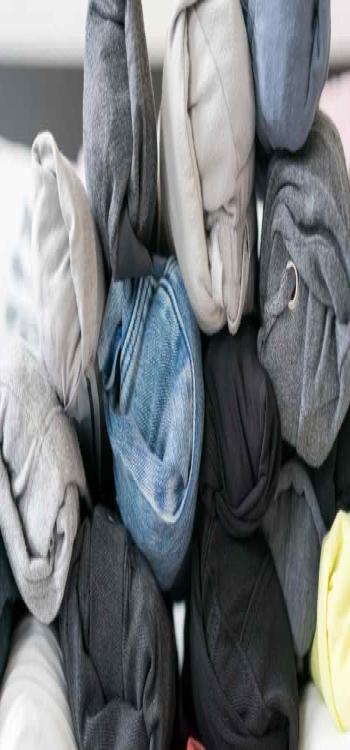
Navigating the intricacies of packing your clothes for a move involves mastering the age-old debate: to roll or to fold? Unravelling the technique guides you towards a space-efficient and wrinkle-free wardrobe for your move.
The Efficiency of the Roll
Rolling clothes is not just a convenient packing method; it’s an art form that maximises space efficiency and minimises wrinkles. Here’s why rolling might be the secret weapon you need for a successful move:
a. Space Maximisation: Rolled clothes occupy less space compared to folded ones, allowing you to make the most of your moving boxes, suitcases, or duffel bags. This becomes especially valuable when dealing with limited packing space.
b. Wrinkle Prevention: The rolling technique reduces the chances of wrinkles and creases, preserving the freshness of your clothes. This is particularly beneficial for delicate fabrics and items prone to creasing during transit.
c. Easy Access: Rolled clothes are easily identifiable, and accessing a specific item doesn’t require disrupting the entire contents of a suitcase or box. This makes unpacking a breeze, especially when time is of the essence.
Pro Tip: To master the art of rolling, follow a tidy rolling technique to avoid creating lumps and uneven surfaces in your packed clothes.
The Time-Tested Tradition of Folding
While rolling has its merits, folding remains a tried-and-true method of packing clothes. Here’s when opting for the fold might be the more suitable choice:
a. Formal Attire and Dress Shirts: For formal attire, dress shirts, or items that benefit from a crisp appearance, folding is the preferred method. It helps maintain the garment’s structure and reduces the risk of wrinkles on smooth fabrics.
b. Uniform Stacking: Folding allows for uniform stacking, creating neat layers within boxes or drawers. This method is advantageous when dealing with a wardrobe that primarily consists of structured items that stack well.
c. Utilising Drawer Space: If you’re moving dressers or other furniture with built-in drawers, folding becomes a practical choice. It allows for easy placement within drawers, optimising the available storage space.
When to Roll and When to Fold
The key to efficient packing lies in understanding when to roll and when to fold. Consider the following guidelines:
a. Roll for Casual Wear: Embrace rolling for casual wear, including t-shirts, jeans, and casual dresses. The space-saving benefits and wrinkle prevention make it ideal for everyday items.
b. Fold for Formal and Structured Items: Reserve folding for formal wear, dress shirts, and items that benefit from a smooth and structured presentation. This ensures a polished look upon arrival at your new destination.
The art of rolling vs. folding is a balancing act that depends on your wardrobe’s composition and the nature of your move. By strategically employing these packing techniques, you’ll not only optimise space but also ensure your clothes emerge from the move looking as fresh as the moment they were packed.
Optimal Use of Specialty Boxes
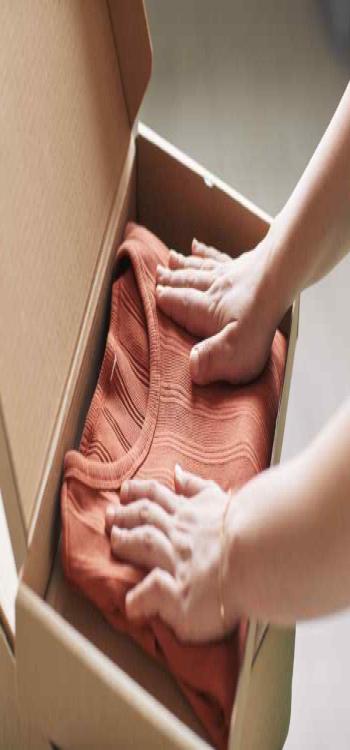
Moving your wardrobe seamlessly involves more than just standard cardboard boxes. Let’s explore the world of speciality boxes, such as wardrobe boxes, unravelling their unique benefits and guiding you on the optimal use of these specialised containers for a stress-free and organised move.
The Versatility of Wardrobe Boxes
Wardrobe boxes are the unsung heroes of a smooth wardrobe transition. These specialised containers are designed to accommodate hanging clothes, ensuring they arrive at your new home wrinkle-free and ready to wear. Let’s delve into why and how to make optimal use of wardrobe boxes:
a. Effortless Hanging Storage: The primary advantage of wardrobe boxes lies in their ability to effortlessly store hanging clothes. Instead of removing clothes from hangers and folding them, simply transfer them directly into the wardrobe box. This not only saves time but also preserves the integrity of your garments.
b. Protection for Delicate Items: For delicate or formal wear that requires extra care, wardrobe boxes provide a protective casing. This is especially beneficial for items like dresses, suits, or high-value garments that deserve an extra layer of safeguarding during the move.
c. Streamlined Unpacking: Upon reaching your new destination, unpacking from a wardrobe box is a breeze. Your clothes remain neatly hung, making it easy to transfer them directly to your new closet without the need for extensive sorting or ironing.
Pro Tip: Wardrobe boxes come in various sizes, so choose the ones that best match your hanging clothes’ quantity and length.
When to Opt for Specialty Boxes
While standard cardboard boxes have their place, there are specific scenarios where opting for speciality boxes can significantly enhance your moving experience:
a. Formal and Delicate Clothing: Specialty boxes, especially wardrobe boxes, are a must for formal and delicate clothing items. The added protection and convenience justify their use for garments that require extra care.
b. Shoes and Accessories: Consider speciality boxes for items beyond clothing. Shoes and accessories, like hats or handbags, can benefit from dedicated containers, ensuring they maintain their shape and condition during the move.
c. Fragile or Valuable Items: If your wardrobe includes fragile or high-value items, speciality boxes offer an added layer of protection. This is particularly relevant for items that are prone to damage or breakage during transit.
Making the Most of Space
To optimise the use of speciality boxes and maximise available space:
a. Strategically Combine Items: When using wardrobe boxes, strategically combine hanging items to make the most of the vertical space. This not only conserves space but also ensures a more stable and secure load.
b. Label Clearly: Clearly label each speciality box to facilitate easy identification during the unpacking process. This saves time and minimises confusion, allowing you to locate specific items swiftly.
The optimal use of speciality boxes, particularly wardrobe boxes, is a game-changer when it comes to moving your wardrobe. By leveraging these specialised containers, you’re not just transporting clothes; you’re ensuring they arrive in pristine condition, ready to seamlessly integrate into your new living space.
Economical Packing Tips

Embarking on a wardrobe move doesn’t have to break the bank. Let’s unveil savvy and budget-friendly packing tips, arming you with cost-effective strategies and DIY solutions that leverage everyday household items. Discover how to pack efficiently without compromising on quality or convenience.
Suitcases and Duffel Bags: Your Budget-Friendly Allies
When it comes to economical packing, your existing luggage can be a game-changer. Utilise suitcases and duffel bags creatively to make the most of their space and structure:
a. Clothes Inside Suitcases: Make your suitcases multitask by filling them with clothes. This not only optimises their use but also ensures your garments are protected during transit. Consider placing heavier items at the bottom to prevent wrinkles.
b. Duffel Bags for Bulky Items: Bulky items like winter jackets, blankets, or even pairs of shoes find a perfect home in duffel bags. The flexible structure of duffel bags allows you to maximise space, and they can easily be squeezed into the nooks and crannies of your moving containers.
Pro Tip: Ensure to pack fragile or breakable items securely within the center of these bags, surrounded by softer items for added protection.
The Magic of Plastic Wrap and Bags
Cost-effective and readily available, plastic wrap and bags can be your allies in securing your clothes and accessories:
a. Wrap Clothing Bundles: Group your clothes into manageable bundles and secure them with plastic wrap. This not only keeps them compact but also prevents shifting during transit. It’s a DIY solution that costs next to nothing but yields significant benefits.
b. Garbage Bags for Hanging Clothes: For a quick and economical way to transport hanging clothes, use garbage bags. Keep your clothes on hangers, slide the bag over them, and tie at the bottom. This protects your garments from dust and moisture while offering a fuss-free packing solution.
Utilise Household Items Creatively
Look around your home, and you’ll find a treasure trove of items ready to assist in your move:
a. Linen and Towels as Padding: Instead of investing in bubble wrap, use your linen and towels to wrap delicate or breakable items. This not only saves on packing supplies but also ensures your linens serve a dual purpose during the move.
b. Shoeboxes for Small Items: Don’t underestimate the humble shoebox. It’s perfect for organising and transporting smaller items like accessories, jewelry, or even socks. Label each box for easy identification during unpacking.
Timing Your Move for Savings
Consider the timing of your move for potential cost savings:
a. Off-Peak Moving Days: If your move date is flexible, consider scheduling it during off-peak days or seasons. Moving companies often offer discounted rates during periods of lower demand.
b. Free Packing Materials: Keep an eye out for free packing materials. Grocery stores or local businesses may have spare boxes available. Just ensure they are sturdy and in good condition for the safe transport of your belongings.
Packing on a budget requires a blend of creativity and resourcefulness. By repurposing household items and embracing DIY solutions, you can move your wardrobe efficiently without draining your wallet.
Properly Packing in Different Types of Boxes
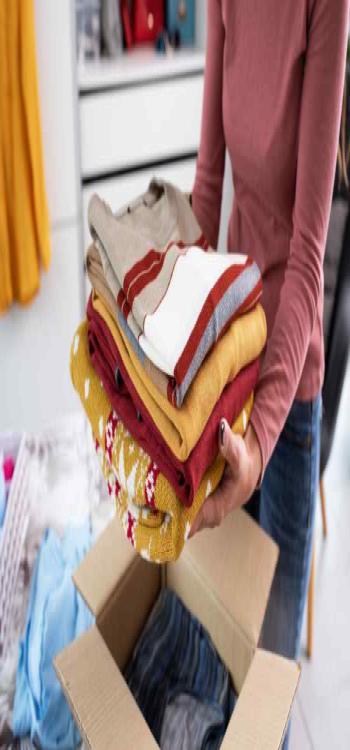
Packing for a move is akin to solving a puzzle, especially when it comes to organising your wardrobe. Let’s delve into the nuances of properly packing different types of boxes, offering a detailed guide on what clothes to pack where and sharing expert tips on arranging items for maximum efficiency.
Standard Moving Boxes: The All-Purpose Workhorses
Standard moving boxes are versatile, accommodating a range of clothing items. Here’s a comprehensive guide on how to make the most of these all-purpose workhorses:
a. Foldable Clothing: Standard moving boxes are ideal for foldable clothing items such as t-shirts, jeans, and casual wear. Ensure a neat fold to optimise space and prevent unnecessary wrinkles.
b. Accessories and Small Items: Utilise smaller moving boxes for accessories like scarves, hats, and jewelry. Place these items in sealable bags or smaller containers within the box to prevent tangling.
c. Organise by Category: Group similar items together to facilitate easy unpacking. For example, dedicate a box to all your socks, another for belts, and so on. Label each box clearly for quick identification.
Wardrobe Boxes: Where Hanging Clothes Find a Home
Wardrobe boxes are the VIPs of clothing transport, especially for hanging items. Here’s how to master the art of packing with wardrobe boxes:
a. Hanging Clothes Only: Reserve wardrobe boxes exclusively for hanging clothes. This includes dresses, suits, blouses, and any items that you prefer to keep on hangers. This method minimises wrinkles and speeds up the unpacking process.
b. Layer Strategically: Maximising space within wardrobe boxes involves strategic layering. Start with longer items at the bottom and layer shorter items on top. This prevents overcrowding and ensures your clothes remain in good condition.
c. Additional Storage at the Bottom: If there’s space at the bottom of the wardrobe box, consider placing shoes or folded items to make the most of every inch. Just be mindful not to overload the box, as it may compromise the integrity of hanging clothes.
3. Vacuum-Sealed Bags: The Space-Saving Marvels
Vacuum-sealed bags are a game-changer when it comes to optimising space. Here’s how to pack different types of clothes using these space-saving marvels:
a. Bulky and Seasonal Items: Use vacuum-sealed bags for bulky and seasonal items like winter jackets, blankets, and heavy sweaters. The compression feature reduces the volume of these items significantly.
b. Proper Folding Matters: Before placing clothes in vacuum-sealed bags, fold them neatly to avoid unnecessary creases. Remember that delicate fabrics may benefit more from rolling than folding when using these bags.
c. Label for Easy Identification: Since vacuum-sealed bags can conceal their contents, label them clearly with the types of clothes inside and any relevant categories. This ensures you can locate specific items without the need to open every bag.
Miscellaneous Tips for Efficient Packing
a. Heavy Items at the Bottom: Regardless of the box type, always place heavier items at the bottom to maintain stability and prevent damage to more delicate items.
b. Utilise Empty Spaces: Fill any gaps or empty spaces within boxes with softer items like socks or linens. This not only optimises space but also provides additional padding for your belongings.
c. Pack Strategically by Destination: If certain items are needed immediately upon arrival, pack them strategically in easily accessible boxes. This ensures you have the essentials at your fingertips without rummaging through all your belongings.
Properly packing different types of boxes requires a strategic approach that considers the nature of your clothes and the specific features of each box. By mastering this art of wardrobe Tetris, you’ll ensure a smooth move and the arrival of your clothes in pristine condition.
Protecting Your Footwear

Embarking on a move doesn’t mean your shoe collection has to suffer. Let’s unravel the secrets to packing shoes without causing damage and share innovative ideas to keep your precious footwear in perfect shape and pristine condition throughout the journey.
Packing Shoes with Care: Preserving Every Step
When it comes to your beloved shoes, a little extra care in packing goes a long way. Here’s a step-by-step guide to ensure your footwear makes the move unscathed:
a. Clean Before You Pack: Begin by giving your shoes a thorough cleaning. Remove any dirt, mud, or debris to prevent stains during transit. For fabric or suede shoes, use an appropriate cleaner, and for leather, a damp cloth should suffice.
b. Stuff Them Right: Maintain the shape of your shoes by stuffing them with soft materials. Consider using tissue paper, socks, or bubble wrap to fill the empty spaces. This not only helps the shoes keep their form but also provides a buffer against potential impacts.
c. Separate with Care: Avoid direct shoe-to-shoe contact by wrapping each pair individually. This prevents scuffs, scratches, and colour transfer. Use soft cloth or shoe bags for added protection.
d. Pack in a Dedicated Box: Consider using a dedicated shoe box or a sturdy moving box for your footwear. This provides an extra layer of protection against external elements and ensures your shoes stay organised during the move.
Pro Tip: For added protection, wrap delicate or high-value shoes in bubble wrap before placing them in individual shoe bags.
Innovative Ideas for Shoe Care on the Move
Preserving the condition of your shoes goes beyond just packing. Explore these innovative ideas to safeguard your footwear throughout the journey:
a. Shoe Bags as Bodyguards: Invest in shoe bags for each pair. These breathable fabric bags provide a shield against dust, moisture, and potential scratches. They are particularly useful for high-end or delicate shoes that require extra care.
b. DIY Shoebox Dividers: Transform regular cardboard boxes into DIY shoebox dividers. Create sections within the box using cardboard or dividers from old shoeboxes to prevent shoes from shifting and colliding during the move.
c. Hang Shoes for Wrinkle-Free Arrival: If you have the space, consider using a hanging shoe organiser. This not only keeps your shoes neatly arranged but also ensures they arrive at your new home wrinkle-free and ready to wear.
Protecting Specific Shoe Types
Different types of shoes require unique protection strategies. Tailor your packing approach based on the characteristics of each shoe type:
a. Boots: Keep tall boots standing upright by stuffing them with rolled-up newspaper or pool noodles. This prevents creases and ensures they maintain their shape.
b. Delicate Heels: For shoes with delicate heels, consider placing a protective layer over the heel, such as bubble wrap or foam padding. Secure it in place with tape to prevent any wobbling or damage.
c. Sneakers and Athletic Shoes: Preserve the integrity of sneakers by placing them in shoe bags and tying the laces together. This not only prevents them from getting separated but also maintains their freshness.
Your shoes are more than just accessories; they’re an investment. By implementing these tips for packing and protecting your footwear, you’ll ensure that every step you take in your new home is as stylish and comfortable as the last.
Handling Accessories and Valuables
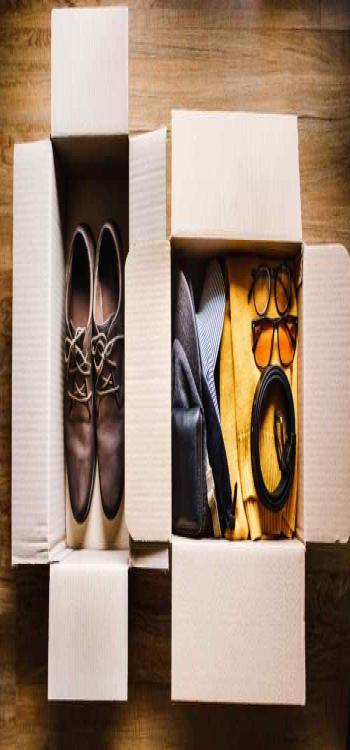
Accessories and valuables add a touch of glamour to your wardrobe, and moving them requires special attention. Lets’ navigate the intricacies of packing and transporting accessories and valuables, offering tips for a secure and accessible journey to your new home.
Separation is Key: Packing Accessories with Precision
Accessories, from jewelry to scarves, demand meticulous care during a move. Here’s how to ensure each piece arrives at your new destination in perfect condition:
a. Jewelry Protection: Invest in small jewelry boxes or use compartmentalised storage to prevent tangles and scratches. For delicate pieces, consider placing them in soft fabric pouches or wrapping them individually in bubble wrap.
b. Scarves and Delicate Fabrics: To avoid wrinkles and snags, fold scarves neatly and place them in sealable plastic bags. For delicate fabrics, use tissue paper or fabric pouches to protect them from dust and potential damage.
c. Belts and Accessories: For belts and small accessories, create a dedicated box or use resealable bags. Keep similar items together to simplify unpacking and reduce the risk of misplacement.
Pro Tip: Photograph each valuable accessory before packing. In case of loss or damage, having visual documentation can aid in the claims process.
Secure and Accessible Packing of Essentials
Certain accessories and valuables are indispensable for daily life. Ensuring they are securely packed yet readily accessible is crucial for a smooth transition:
a. Essential Accessories Kit: Create a designated essentials kit containing accessories crucial for daily wear. This can include a few pieces of jewelry, a watch, and other items you use daily. Pack this kit in a small, easily accessible bag.
b. Secure Storage for Valuables: For high-value items like watches or heirloom jewelry, consider using a small, lockable box. This provides an additional layer of security during the move. Keep the key or combination in a separate, safe location.
c. Documentation and Safekeeping: If your accessories hold sentimental or monetary value, ensure you have proper documentation. Take photographs, note serial numbers, and keep any certificates of authenticity in a secure folder. This not only aids in identification but also facilitates insurance claims if necessary.
Customised Packing for Specific Items
Different accessories require tailored packing strategies to ensure their safety and condition upon arrival:
a. Hats and Headpieces: Use sturdy hat boxes or pack hats in large, resealable plastic bags. Stuff the insides with tissue paper to maintain their shape and protect against crushing.
b. Watches: Place watches in their original boxes or use padded watch cases. If the original packaging is not available, wrap each watch in bubble wrap and secure them in a padded container to prevent scratches and impacts.
c. Delicate Sunglasses: Sunglasses deserve special care. Use hard-shell cases or wrap them in soft microfiber cloths before placing them in a protective box. Avoid stacking heavy items on top of sunglasses to prevent damage.
Handling accessories and valuables during a move requires a delicate balance between security and accessibility. By adopting these strategies, you’ll not only safeguard your cherished items but also ensure they remain easily within reach for those finishing touches that elevate your everyday style.
Preparing a ‘First-Day’ Bag

The chaos of the moving day is behind you, and the anticipation of settling into your new home is high. To ensure a smooth transition, consider the importance of a well-prepared ‘First-Day’ bag. Let’s guide you on the significance of this bag and provide a comprehensive list of items to include for those crucial first few days in your new abode.
The Significance of a ‘First-Day’ Bag
As you step into your new space, the last thing you want is to rummage through boxes searching for essentials. A ‘First-Day’ bag is your secret weapon for an organised and stress-free arrival:
a. Immediate Access: The ‘First-Day’ bag contains items you’ll need right away, sparing you the hassle of unpacking boxes to find your toothbrush, pyjamas, or the coffee mug that starts your day.
b. Transitional Comfort: Moving can be exhausting. Having a bag with your essentials ensures you can comfortably transition from the chaos of unpacking to a restful first night in your new home.
c. Emergency Preparedness: Unexpected situations may arise, from delayed deliveries to unforeseen challenges. Your ‘First-Day’ bag serves as a safety net, containing items that can tide you over until the rest of your belongings are unpacked.
Crafting Your ‘First-Day’ Bag Checklist
Pack your ‘First-Day’ bag with care, ensuring you have everything you need for those initial days of adjustment. Here’s a comprehensive checklist to guide you:
a. Clothing: Pack a change of clothes for each family member, including underwear and sleepwear. This ensures everyone is comfortable after a long day of moving.
b. Toiletries: Essential toiletries such as toothbrushes, toothpaste, soap, shampoo, and towels should be easily accessible. Consider travel-sized items to save space.
c. Medications: If anyone in the family takes regular medications, ensure an ample supply for the first few days. This is crucial until you can locate your pharmacy or transfer prescriptions.
d. Important Documents: Keep important documents like IDs, passports, lease agreements, and any relevant paperwork in a secure folder. This ensures quick access when needed.
e. Snacks and Refreshments: Pack non-perishable snacks and beverages to keep everyone energised during the unpacking process. Consider items like granola bars, nuts, and bottled water.
f. Electronics and Chargers: Don’t forget phone chargers, laptop chargers, and any other electronic devices you may need. Charge them before the move to ensure immediate use.
g. Basic Kitchen Supplies: Include a few disposable plates, cups, and utensils, along with a small pot or pan. This allows you to prepare simple meals until your kitchen is fully set up.
h. Bedding: Pack bed linens and pillows to ensure a comfortable night’s sleep. This is especially important if you haven’t had a chance to set up your bed frame.
i. Basic Cleaning Supplies: A small supply of cleaning essentials, such as wipes or a multi-purpose cleaner, can help you freshen up your space before fully unpacking.
Pro Tip: Label your ‘First-Day’ bag clearly and keep it with you during the move. This ensures it doesn’t get mixed up with other boxes and is easily accessible upon arrival.
The Unpacking Ritual
Upon reaching your new home, prioritise unpacking your ‘First-Day’ bag. This ritual not only sets the tone for a well-organised move but also provides a moment of respite before diving into the larger unpacking tasks.
Crafting a well-thought-out ‘First-Day’ bag is a small investment that pays off significantly during the hustle and bustle of moving day. By ensuring immediate access to your essentials, you’ll transform the first day in your new home into a comfortable and enjoyable experience.
Smart clothes packaging ideas can transform your moving experience into a whole new level. Declutter your wardrobe, strategically pack by season, and embrace space-saving techniques like rolling. As you embark on this journey, consider the invaluable ‘First-Day’ bag for immediate essentials.
Packing clothes may seem daunting, but it’s an art worth mastering. For a hassle-free move, trust NoBroker packers & movers. Their expertise ensures your clothes packaging is efficient and stress-free. Simplify your move and bid farewell to packing woes. Plan smartly, pack wisely, and let NoBroker packers & movers redefine your moving experience.
Experience a seamless move. Consult NoBroker packers & movers for a stress-free transition!
Frequently Asked Questions
Elevate your shipping experience with whimsical touches like personalised notes, fabric bows, or eco-friendly wrapping. Discover creative ways to make your package as charming as its contents!
Certainly! Opt for budget-friendly options like repurposed boxes, trash bags, or even reusing suitcases for efficient and cheap packaging ideas for clothing
Explore inspiring and trendy Pinterest clothes packaging ideas to infuse creativity into your packing journey. Pinterest is a treasure trove of stylish and innovative packaging concepts for your wardrobe!
Explore eco-friendly chic with paper clothes packaging ideas! Try origami-inspired folds or personalised paper wraps for a sustainable and stylish touch.
Elevate your brand with unique touches like eco-friendly materials, personalised notes, and stylish reusable packaging











